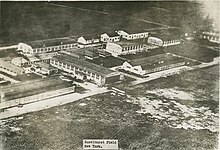George M. Stratton
George Malcolm Stratton (September 26, 1865 – October 8, 1957) was an American psychologist who pioneered the study of perception in vision by wearing special glasses which inverted images up and down and left and right.
Stratton left for Johns Hopkins University in the early 1900s and spent a few years as faculty at the psychology department before returning to Berkeley.
He was optimistic that people and ethnicities, making up nations, could be taught to live in peace, though the races were not equal in inborn mental capacity, a belief he held as scientific.
The remaining, including one unfinished at his death, were on sociology, international relations and the issues of war and how findings from psychology could be used to eradicate conflict between nations.
Stratton considered these issues more salient to the application of psychology in the real world, though his ideas on this front did not produce a lasting impact in the field because of their subjective and non-experimental nature.
The senior Stratton traced his ancestry to the early settlers of the British settlements of America, and Cornelia Smith had Dutch and English forebears.
[2] One of his sons, Frederick, went to the University of California, today's Berkeley, and became a lawyer, state senator, and Collector of the Port of San Francisco, before killing himself on November 30, 1915.
One of Stratton's psychology students in the Philosophy department was Knight Dunlap, a later chair at Johns Hopkins and University of California, Los Angeles.
[32] Stratton left Berkeley at end of June, 1904,[33] and moved east to Johns Hopkins University as a professor of experimental psychology in October.
Edward L. Thorndike pooled Stratton's results with other studies to statistically analyze and correlate weak performance to a poor flying record.
Part of this research was carried out in the spring of 1918 with Captain Henmon at Kelly Field, and the army thought enough of the results to allow the tests for checking recruits in four new units.
[47] Stratton also taught at Berkeley's extension school, lecturing on "Psychology and health" in San Francisco to people from the medical profession in 1918–19, and in Oakland in 1919–20.
[55] His daughter, Elenore, would recall decades later living in the house, with a view of the San Francisco bay and the Golden Gate on one side and the Marin county hills beyond.
[55] Elenore also recalled his night-time reading of Homer to his children, mixing with fascinating guests for weekend suppers prepared by her mother, and the family camping out with Latin professor "Uncle" Leon Richardson.
Wundt's lab in Leipzig, with experimental programs bringing together the fields of evolutionary biology, sensory physiology and nervous-system studies, was a part of the career of most of the first generation.
This out-of-body experience, caused by an altered but normal sensory perception, vanished when he attended to the issue critically, focusing on the disconnect.
The courses included sensation, perception, emotion, memory, and applications of psychology to professions such as law, medicine, schooling and clerical work by priests.
[27] Stratton continued his experiments on perception, branching into studies on pseudoscopic vision, stereoscopic acuity, eye movements, symmetry and visual illusions, how people perceive depth seeing surroundings either one-eyed or two-eyed, acuity and limits of peripheral vision, apparent motion, afterimages impressed on the eye when a person stares at an object for long and then looks away, and problems with sight in half the visual field (hemianopsia).
He also surveyed and reported in reviews in the Psychological Bulletin experiments at various labs, including those in Europe, on matters related to sensation and perception.
[72] His book Developing Mental Power was a foray into educational psychology, addressing the question of general versus specific training in terms teachers could understand and use.
[76] His psychology sought to explain how our need to grasp, accept and live with conceptual opposites such as the sublime and the devilish, the humble and the proud, and the docile and the energetic, led us in the direction of religion.
He concluded Western civilization was trending toward denying rage as good and accepting love and goodwill as desirable, but cautioned anger was at times needed to fight evil.
His PhD thesis, Über die Wahrnehmung von Druckänderungen bei verschiedenen Geschwindigkeiten, was in German and published in Leipzig in Wundt's Philosophische Studien, XII Band, IV Heft.
That we could simultaneously hear separately, without synthesizing, multiple mixed tones meant our experiences did not necessarily come in single file temporally.
[88] This last was rebutted by Charles Samuel Myers, writing in Nature, who saw poetry and its rhythm as too complex a subject to be reduced to the arithmetic of attention spans.
Still he concluded, from observations that people were not always aware of how their own perception differed from sensory reality, that a diluted form of the dualist theory was tenable.
[85] Myers critiqued the book's treatment of illusions, memory, and relationship of psychology to body and soul, as not addressing the broader aspect of "culture".
Sandelius also saw Stratton as pushing more for re-educating the mind rather than training people to control emotions and passions in the efforts to avert war.
Many of his other books and articles which dealt with philosophical and sociological issues either beyond, or treated via perspectives beyond, exact and objective investigation had lost appeal to psychology researchers by the time of his death.
[62] The art exhibit Upside-down Mushroom Room by Belgian artist Carsten Höller, a tunnel installation with an inverted environment, builds on Stratton's work.



